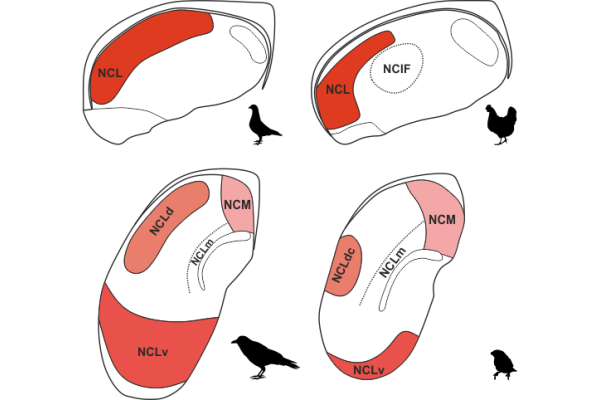2020-02-05

Approximately 40 years ago, Divac and colleagues first described the analogue to the prefrontal cortex (PFC) in birds known as the nidopallium caudolaterale (NCL). The NCL is comparable to the PFC as that both are seen as the seat of complex behaviors such as working memory and decision making. The past decades of research also demonstrated striking parallels in the underlying connectivity and physiology. Up until now, the location of the NCL had been described in pigeon only, and we knew close to nothing about the borders of the NCL in other bird species. This is problematic because there is considerable variation in both brain structure and behavioral capacities between different bird species. By visualizing the dopaminergic innervation of the forebrain, which is a hall-mark method to identify both the NCL and the PFC, a team of the Biopsychology lab set out to delineate the NCL in chicken, zebra finch and the carrion crow. They found that whereas the trajectory of the NCL in chicken is very similar to pigeon, the zebra finch and crow show a strikingly different pattern. In these two songbirds, the NCL now spans across the entire back of the forebrain and seems split up in to more distinct sub-units. These findings commensurate to what has been observed in mammals; the PFC in chimpanzees is both larger and more parcellated compared to rats. Thus, this study discloses yet another instance of the remarkable parallel evolution of the executive brain structure in birds and mammals.
von Eugen, K., Tabrik, S., Güntürkün, O. and Ströckens, F. (2020). A comparative analysis of the dopaminergic innervation of the executive caudal nidopallium in pigeon, chicken, zebra finch, and carrion crow. Journal of Comparative Neurology. https://doi.org/10.1002/cne.24878

Approximately 40 years ago, Divac and colleagues first described the analogue to the prefrontal cortex (PFC) in birds known as the nidopallium caudolaterale (NCL). The NCL is comparable to the PFC as that both are seen as the seat of complex behaviors such as working memory and decision making. The past decades of research also demonstrated striking parallels in the underlying connectivity and physiology. Up until now, the location of the NCL had been described in pigeon only, and we knew close to nothing about the borders of the NCL in other bird species. This is problematic because there is considerable variation in both brain structure and behavioral capacities between different bird species. By visualizing the dopaminergic innervation of the forebrain, which is a hall-mark method to identify both the NCL and the PFC, a team of the Biopsychology lab set out to delineate the NCL in chicken, zebra finch and the carrion crow. They found that whereas the trajectory of the NCL in chicken is very similar to pigeon, the zebra finch and crow show a strikingly different pattern. In these two songbirds, the NCL now spans across the entire back of the forebrain and seems split up in to more distinct sub-units. These findings commensurate to what has been observed in mammals; the PFC in chimpanzees is both larger and more parcellated compared to rats. Thus, this study discloses yet another instance of the remarkable parallel evolution of the executive brain structure in birds and mammals.
von Eugen, K., Tabrik, S., Güntürkün, O. and Ströckens, F. (2020). A comparative analysis of the dopaminergic innervation of the executive caudal nidopallium in pigeon, chicken, zebra finch, and carrion crow. Journal of Comparative Neurology. https://doi.org/10.1002/cne.24878